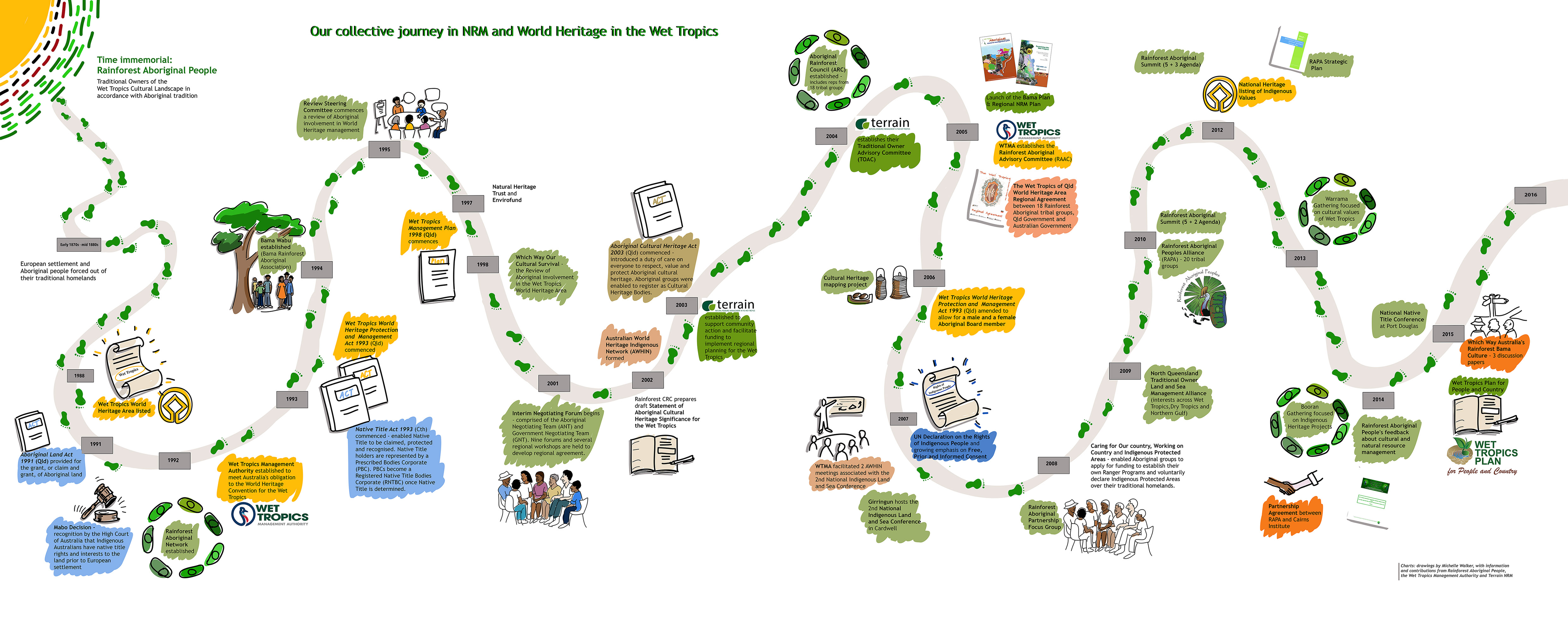
- Wet Tropics Management
- Legislative framework
- Management partnerships
- Sustainable Tourism Plan
- Threats to the Area
- Research and a Learning Landscape
- How can I help?
In 2016 and in partnership with Terrain, the Authority invited a number of Rainforest Aboriginal people with a diverse range of knowledge and experience in World Heritage and NRM to an informal conversation to provide advice on the most appropriate ways both organisations could engage with and continue to support Rainforest Aboriginal people to pursue their interests and aspiration in relation to knowledge, culture and management practice in the Wet Tropics. Our collective journey in NRM and World Heritage was represented visually in a timeframe below.

The listing of the Wet Tropics World Heritage Area in 1988 was not without controversy. Some Rainforest Aboriginal people did not originally support the listing of natural values (in isolation of cultural values) however others did support the international recognition and protection of the Area. Bama Wabu was established in 1994 to lead development of a Rainforest Aboriginal peoples submission called “Reasonable Expectations or Grand Delusions” (1996) that persuaded the Authority to consider Aboriginal issues in the development of the Wet Tropics Management Plan 1998.
In 1998 a Review Steering Committee presented a report to the Authority, called “Which Way Our Cultural Survival” (1998), defining 163 recommendations for how Aboriginal people should be involved in the management of the Wet Tropics World Heritage Area. An Interim Negotiating Forum (INF) was formed to address these recommendations and resolve how to better involve Rainforest Aboriginal people in the management of the Wet Tropics World Heritage Area. The INF negotiations resulted in the preparation of a regional agreement.
On the 29 April 2005, the Wet Tropics World Heritage Area Regional Agreement was signed to provide a framework for the cooperative management of the World Heritage Area by Rainforest Aboriginal people, the Australian and Queensland Governments.
An Aboriginal Natural and Cultural Resource Management Plan (Bama Plan) was also launched at this time to promote natural and cultural resource management considerations and define the aspirations that Rainforest Aboriginal people have for country and culture. The Bama Plan was prepared and implemented with the support of Terrain NRM (Terrain) and a Traditional Owner Advisory Committee (TOAC).

The Regional Agreement led to an amendment in the Wet Tropics World Heritage Protection and Management Act 1993, to include two Rainforest Aboriginal Directors on the Authority’s Board. At the same time, the Authority established a Rainforest Aboriginal Advisory Committee (RAAC) as a Statutory Advisory Committee under section 40(4) of The Act. The RAAC’s role was to represent the views of Rainforest Aboriginal people specifically in relation to the management of the Wet Tropics World Heritage Area and provide advice to the Authority’s Board. The RAAC membership comprised the same 12 tribal group representatives as on the Aboriginal Rainforest Council (ARC) - a peak advisory body formed to facilitate discussions between Rainforest Aboriginal people, the Australian and Queensland Governments.
The ARC was dissolved in 2008 which meant that the protocols, processes and objectives in the Regional Agreement could not be implemented. The pressure for RAAC to be the voice for all Rainforest Aboriginal concerns increased although they were not mandated to do so. The RAAC (and Terrain NRM’s Traditional Owner Advisory Committee) dissolved in 2011 at the request of its members.
A regional alliance of Rainforest Aboriginal people emerged in 2008. The Rainforest Aboriginal People’s Alliance (RAPA) formed in 2010. RAPA’s focus is to provide Rainforest Aboriginal people with a more self-determining network for engaging on a broad range of interests within the region. RAPA convened a Rainforest Aboriginal summit in 2011 to develop their strategic plan; the Warrama Summit in 2013 to discuss the key heritage values of the region; and the Booran gathering in 2014 to develop a partnership agreement with the Cairns Institute and CSIRO to deliver Indigenous Heritage projects. Three discussions papers were prepared in 2015, that focused on Indigenous led management, relisting the cultural values for World Heritage, economic development and sustainable livelihoods.
At the 2018 Rainforest Aboriginal Peoples’ Regional Forum, Dr Alan Dale, professor of tropical regional development at James Cook University, presented the three discussion papers that had been written in 2015:
A resolution was passed by the participants at the forum to allow for a one-month time frame to allow Rainforest Aboriginal People, RNTBC’s and other Rainforest Aboriginal organisations to consider the papers before being formally published. The papers have now been endorsed.
Since the disbanding of the RAAC, the Authority’s focus has been to engage with Rainforest Aboriginal people at the local level and through sub-regional organisations. A range of project-based outcomes have been achieved with this approach.
Rainforest Aboriginal people are also included in the membership of the Authority’s two Statutory Advisory Committees (i.e. Community Consultative Committee and Scientific Advisory Committee) and two non-statutory committees (i.e. Cassowary Recovery Team and the Yellow Crazy Ant Project Reference Committee).
